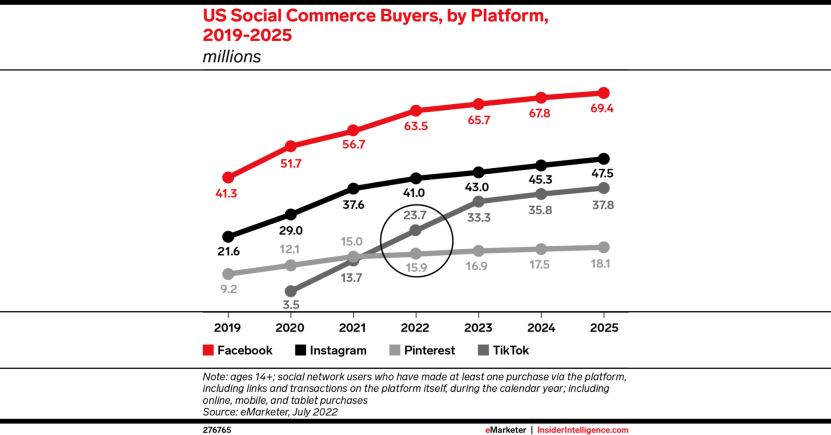Social Commerce Strategy: Unlocking the Secrets to Higher Conversions

Social commerce is reshaping how businesses sell online. Discover the strategies that drive customer engagement and boost conversions through social platforms.
Social media and commerce allows consumers to feel connected to the brands they purchase from. This proximity results in more loyal customers. Social commerce can help expand your reach and increase sales.
Key takeaways
- Social commerce growth: Social media platforms like Instagram, Facebook, and TikTok are increasingly used for direct buying and selling, helping brands expand their reach and drive sales.
- Key benefits: Social commerce offers increased reach, improved engagement, higher conversion rates, and stronger customer loyalty.
- Winning strategy: A successful social selling strategy combines omnichannel commerce, social media engagement, and consistent customer communication.
- Future outlook: Social selling is becoming an essential part of eCommerce, enabling brands to connect with consumers and control brand perception in real time.
On this page:
What is social commerce?
Social commerce is all about making your brand accessible online as well as offline in order to meet the needs of today's omnichannel shopper. Social selling takes that approach one step further by tapping into the power of social media to sell both digital and physical products.
With this strategy, brands can leverage social media platforms such as Facebook, Instagram, and Pinterest to advertise their product offerings. They can also take advantage of promotions such as discount codes or flash sales via social channels where they are most effective. Some of the key features of social commerce are:
User-generated content: This is one of the most important features of social commerce. User-generated content includes product reviews, ratings, and comments. This type of content is created by users and shared with other users.
Product recommendations: Social commerce platforms use the power of social networking to recommend products to users. These recommendations are based on the user’s social graph, which includes the user’s friends and followers.
Peer-to-peer transactions: Social commerce platforms enable users to buy and sell products directly from each other. This type of transaction is known as a peer-to-peer transaction.

The rise of social commerce
Social commerce has been gaining grounds in recent years with the social medias pushing new selling features to create a close circle from marketing to purchase. Social stores and brands offering instant buying options on their social channels, has become a popular way for companies to grow their audience and sales.
The popularity of social medias like Instagram, Facebook, Twitter, Snapchat, and Tiktok, just made this new selling channel explode over the last few years. Social media can be used to drive traffic to your website and social selling can help generate sales. A well-executed social strategy can help boost conversions by 15%.

The benefits of social selling are endless but the most important thing is that you know who your target customers are before launching any type of campaign. Once you have done that, create a well thought out strategy that integrates both omnichannel commerce and social selling into one cohesive plan for success. Social selling helps you reach new potential customers, build brand awareness, and convert leads into buyers.
The key to social selling is consistency. If done right, social media will get people talking about your company. Social marketing also allows you to stay connected with your customers no matter what device they're on. Social commerce gives shoppers more ways than ever to find what they want - or need - when they want it or need it.
How to create a winning social selling strategy
Social selling has been around since the beginning of the social media age, but now we are seeing a shift in strategy. Trends show that brands are trying new ways to combine social media with omnichannel commerce. On top of that, many brands are rethinking their approach by going where the customer is. This can be done by integrating social media into your entire customer journey.
- Integrating social media with omnichannel commerce: Going where the customer is (following them from social media platforms to offline channels)
- Constant customer communication by using social networks as live customer service
- Taking advantage of interactive features on platforms such as Facebook Live or Snapchat Stories to create more engaging content.
- Creating an online community for customers to share product reviews, brand insights and collaborate.
- Bridging physical store experiences with social media so customers never miss out on any opportunities. -Recognizing that social selling is more than just advertising and developing a holistic marketing plan for social media campaigns.
- Combining social media with social CRM to understand who your customer base is and what they need.
- Knowing when/where/how to use social media as a sales channel, and doing this at scale through having all members of your team contribute

Social selling strategies vary depending on company size and what business model they have. But one thing's for sure--social media should play an important role in whatever social strategy you're using!
Omnichannel commerce offers an opportunity for brands to connect to shoppers across different digital touch points, including social media. Social selling isn't about just advertising anymore; there's so much more involved than that. Develop a holistic marketing plan for social media campaigns by combining social media with social CRM.
What are the benefits of social commerce?
Social commerce meets consumers where they are and offers businesses a more relaxed environment to connect with their audience.
Some of the key benefits of social commerce include:
Increased reach: Social commerce platforms have millions of users, this gives businesses a larger audience to sell their products.
Improved engagement: Social commerce platforms provide a more interactive way to engage with customers. When brands are genuine, they can create strong customer relationship and loyalty.
Higher conversion rates: Social commerce platforms have been shown to have higher conversion rates than other types of e-commerce platforms. When meeting customers where they are and creating relevant content, the conversion rate is proven to be higher than regular marketing channels.
Increased brand awareness: With their millions of users, social media can make or break you. When it makes you, the impact on your brand can be outstanding. Taking time to create great content can go along way.
Improved customer loyalty: Social commerce platforms can help businesses to improve customer loyalty. By engaging with people on a regular basis, it will encourage then to interact with you.
Take social commerce further
It's predicted that social selling will be a mainstay of eCommerce.
Social media is the protagonist of social commerce. With platforms like Instagram, Facebook, Pinterest, Snapchat, Twitter, etc., brands have canvas to create and share their stories: pictures of their day-to-day activities, behind the scenes, brand secrets, advice and much more. This vulnerability allows brands to create connections with their followers and receive real time feedback.
The social medias have double down on the efforts to create the perfect platforms for selling. They provides a way to find out what customers want or need before they even know it. Social media users are also encouraged to use customer service like tracking social conversations about products, following hashtags, saving favorites etc.. These actions help brands put the right products at the right time on their feed.

What should you do?
Choose one or two specific social networks and tailor your strategy to those channels specifically instead of trying to manage all at once.
If you plan to use social media for business purposes, make sure you have a social media management team in place who understands the intricacies of each network. It's helpful to think about strategies that involve not only product promotion but also branding and customer support.
For example, some sellers may offer incentives if customers post photos using their hashtag on Instagram or provide product demonstrations via YouTube videos. You'll never know which channel might end up being your company's most profitable!
Read blogs to learn new ways of successfully implementing social marketing initiatives and focus on creating new relationships rather than solely making sales. Be open minded when approaching different forms of social selling, try new things and keep testing until something sticks!
Use social media to understand your target audience, identify their needs and wants, then go beyond social selling - share industry knowledge through blog posts, tweets, pins and more.
Maintain transparency throughout the process - let consumers know what you're doing behind-the-scenes. Engage with other influencers in your industry through shares, comments and retweets to build trust amongst potential consumers.
Social media is an excellent platform to showcase your expertise, show others how your products benefit the community, and communicate the culture of your brand.
Finally, think outside the box and don't limit yourself to social selling. Find ways to incorporate social media into other aspects of your business, like marketing, promotions and PR.
The future of social commerce
Social media has been a great innovation to stay in touch with friends, family, and follow influencers. However, in recent years it is also becoming the place where we can find everything they need and directly buy it.
Social selling should become a part of every brands' strategy and beyond because consumers expect brands to be presence where they are. Social media is a great asset to leverage to start conversations about your brand and receive feedback about your products.
While social media is sophisticated at matching customers with personalized offers that are tailored specifically to them and providing value-added services, social media strategy should focus on how can a brand be genuine and offer valuable content.
As social media transforms into an omnichannel commerce tool, social selling becomes an integral part of this ecosystem.
If done right, social selling can become an integral part of your sales funnel. It is faster to setup than an online store and business can see results almost instantly.
Social selling allows brands to interact directly with consumers and gives them greater control over brand perception.
Want to learn more about the trends of social commerce, keep an eye out for our upcoming article!













